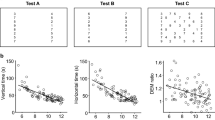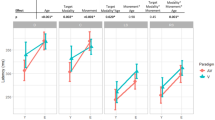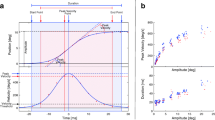Abstract
To our knowledge, there are no studies exploring the development of voluntary and reflexive saccades in children using different types of paradigms to investigate horizontal saccades. In the present study, we examined the development of horizontal saccades in children aged 6–15 years. Binocular eye movements were recorded using an infrared video-oculography system (mobileEBT®, e(ye)BRAIN) in seventy-two children (aged 6–15). Several paradigms were used to stimulate reflexive and voluntary horizontal saccades: gap, step and overlap paradigms. Horizontal anti-saccades were also examined. In all paradigms, the latency of saccades decreased with the age of children and it did not depend on the direction of the saccades (left/right); the error rate in the anti-saccade task decreased with age; the gain of horizontal saccades improved with age; the peak velocity of horizontal saccades was stable throughout childhood. We conclude that saccadic performances are influenced by age and cortical circuits responsible for the preparation of reflexive or voluntary saccades are completed at 12 years old. These data could be used as reference values for further studies dealing with pathologic development.





Similar content being viewed by others
References
Amado N, Schlag-Rey M, Schlag J (1998) Primate antisaccades. I. Behavioral characteristics. J Neurophysiol 80(4):1775–1786
Bell AH, Everling S, Munoz DP (2000) Influence of stimulus eccentricity and direction on characteristics of pro- and antisaccades in non-human primates. J Neurophysiol 84(5):2595–2604
Bucci MP, Pouvreau N, Yang Q, Kapoula Z (2005) Gap and overlap effect on latency of saccades and vergence in 7 years old children. Exp Brain Res 164(1):48–57
Bucci MP, Nassibi N, Gerard C-L, Bui-Quoc E, Seassau M (2012) Immaturity of binocular saccade coordination in dyslexic children: evidence from a reading and visual search study. PLoS One 7(3):e33458
Edelman JA, Goldberg ME (2001) Dependence of saccade-related activity in the primate superior colliculus on visual target presence. J Neurophysiol 86(2):676–691
Edelman JA, Valenzuela N, Barton JJS (2006) Antisaccade velocity, but not latency, results from a lack of saccade visual guidance. Vis Res 46:1411–1421
Ettinger U, Kumari V, Chitnis XA, Corr PJ, Sumich AL, Rabe-Hesketh S, Crawford TJ, Sharma T (2002) Relationship between brain structure and saccadic eye movements in healthy humans. Neurosci Lett 328(3):225–228
Everling S, Fischer B (1998) The antisaccade: a review of basic research and clinical studies. Neuropsychologia 36(9):885–899
Everling S, Munoz DP (2000) Neuronal correlates for preparatory set associated with pro-saccades and anti-saccades in the primate frontal eye field. J Neurosci 20(1):387–400
Findlay JM, Walker R (1999) A model of saccade generation based on parallel processing and competitive inhibition. Behavioural and Brain Sciences 22:661–674
Fioravanti F, Inchingolo P, Pensiero S, Spanio M (1995) Saccadic eye movement conjugation in children. Vis Res 35:3217–3228
Fischer B (1997) The preparation of visually-guided saccades. Rev Physiol Biochem Pharmacol 106:1–35
Fischer B, Biscaldi M, Gezeck S (1997) On the development of voluntary and reflexive components in human saccade generator. Brain Res 754:285–297
Fukushima J, Hatta T, Fukushima K (2000) Development of voluntary control of saccadic eye movements I. Age-related changes in normal children. Brain Dev 22:173–180
Funahashi S, Chafee MV, Goldman-Rakic PS (1993) Prefrontal neuronal activity in rhesus monkeys performing a delayed anti-saccade task. Nature 365(6448):753–756
Gogtay N, Giedd JN, Lusk L, Hayashi KM, Greenstein D, Vaituzis AC, Nugent TF, Herman DH, Clasen LS, Toga AW, Rapoport JL, Thompson PM (2004) Dynamic mapping of human cortical development during childhood through early adulthood. Proc Natl Acad Sci USA 101(21):8174–8179
Hallet P (1978) Primary and secondary saccades to goals defined by instructions. Vis Res 18:1279–1296
Hutton SB (2008) Cognitive control of saccadic eye movements. Brain Cogn 68(3):327–340 (Review)
Irving EL, Steinbach MJ, Lillakas L, Babu RJ, Hutchings N (2006) Horizontal saccade dynamics across the human life span. Invest Ophthalmol Vis Sci 47(6):2478–2484
Irving EL, Tajik-Parvinchi DJ, Lillakas L, González EG, Steinbach MJ (2009) Mixed pro and antisaccade performance in children and adults. Brain Res 19(1255):67–74
Kingstone A, Klein RM (1993) Visual offsets facilitate saccadic latency: does predisengagement of visuospatial attention mediate this gap effect? J Exp Psychol Hum Percept Perform 19:1251–1265
Klein C (2001) Developmental functions for saccadic eye movement parameters derived from pro- and antisaccade tasks. Exp Brain Res 139:1–17
Klein C, Foerster F (2001) Development of prosaccade and antisaccade task performance in participants aged 6 to 26 years. Psychophysiology 38:179–189
Leigh RJ, Zee DS (2006) The neurology of eye movement, 4th edn. Oxford University Press, New York
Luna B, Sweeney JA (1999) Cognitive functional magnetic resonance imaging at very-high-field: eye movement control. Top Magn Reson Imaging 10:3–15
Luna B, Velanova K, Geier CF (2008) Development of eye-movement control. Brain Cogn 68:293–308
Lynch JC, Tian JR (2005) Cortico-cortical networks and cortico-subcortical loops for higher control of eye movements. Prog Brain Res 151:461–501
Malone SM, Iacono WG (2002) Error rate on the antisaccade task: heritability and developmental change in performance among preadolescent and late-adolescent female twin youth. Psychophysiology 39:664–673
Matsuda T, Matsuura M, Ohkubo T, Ohkubo H, Matsushima E, Inoue K, Taira M, Kojima T (2004) Functional MRI mapping of brain activation during visually guided saccades and anti-saccades: cortical and subcortical networks. Psychiatry Res 131(2):147–155
McDowell JE, Dyckman KA, Austin BP, Clementz BA (2008) Neurophysiology and neuroanatomy of reflexive and volitional saccades: evidence from studies of humans. Brain Cogn 68:255–270
Munoz DP, Everling S (2004) Look away: the anti-saccade task and the voluntary control of eye movement. Nat Rev Neurosci 5(3):218–228
Munoz DP, Broughton JR, Goldring JE, Armstrong IT (1998) Age-related performance of human subjects on saccadic eye movement tasks. Exp Brain Res 121:391–400
Nyström M, Holmqvist K (2010) An adaptive algorithm for fixation, saccade, and glissade detection in eyetracking data. Behav Res Methods 42(1):188–204
Olk B, Kingstone A (2003) Why are antisaccades slower than prosaccades? A novel finding using a new paradigm. NeuroReport 14(1):151–155
Optican LM (2005) Sensorimotor transformation for visually guided saccades. Ann NY Acad Sci 1039:132–148
Pierrot-Deseilligny C, Rivaud S, Gaymard B, Muri R, Vermersch AI (1995) Cortical control of saccades. Ann Neurol 37:557–567
Reuter-Lorenz PA, Hughes HC, Fendrich R (1991) The reduction of saccadic latency by prior offset of the fixation point: an analysis of the gap effect. Percept Psychophys 49(2):167–175
Salman MS, Sharpe JA, Eizenman M, Lillakas L, Westall C, To T, Dennis M, Steinbach MJ (2006) Saccades in children. Vis Res 46:1432–1439
Sweeney JA, Mintun MA, Kwee S, Wiseman MB, Brown DL, Rosenberg DR, Carl JR (1996) Positron emission tomography study of voluntary saccadic eye movements and spatial working memory. J Neurophysiol 75(1):454–468
Toga AW, Thompson PM, Sowell ER (2006) Mapping brain maturation. Trends Neurosci 29:148–159
Acknowledgments
Authors thank the directors and the teachers of the Collège Saint André (Saint Maur des Fossés) and of the elementary school Lamazou (Paris) for allowing ocular motor tests, parents and children for their kind participation and Savita Bernal for revising the English version of the manuscript.
Conflict of interest
Authors have no financial and personal relationships with other people or organisations that could inappropriately influence or bias their work in this study.
Author information
Authors and Affiliations
Corresponding author
Rights and permissions
About this article
Cite this article
Bucci, M.P., Seassau, M. Saccadic eye movements in children: a developmental study. Exp Brain Res 222, 21–30 (2012). https://doi.org/10.1007/s00221-012-3192-7
Received:
Accepted:
Published:
Issue Date:
DOI: https://doi.org/10.1007/s00221-012-3192-7




